When insulating an underground food pit, you'll want to choose from these top 7 materials: Foamglas cellular glass for its exceptional moisture resistance and strength, ceramic mats for superior temperature control up to 1,700°C, moisture-resistant Kaiflex with its antimicrobial properties, thick layered Styrofoam walls for reliable insulation, natural materials like straw bales for eco-friendly options, fiberglass with protective jacketing for pest resistance, and multi-layer ventilated systems for ideal preservation. Each material offers unique benefits, from moisture control to temperature stability, and combining them strategically can create the perfect storage environment. Let's explore how to maximize each material's potential for your food storage needs.
Polyisocyanurate Underground Storage Layers
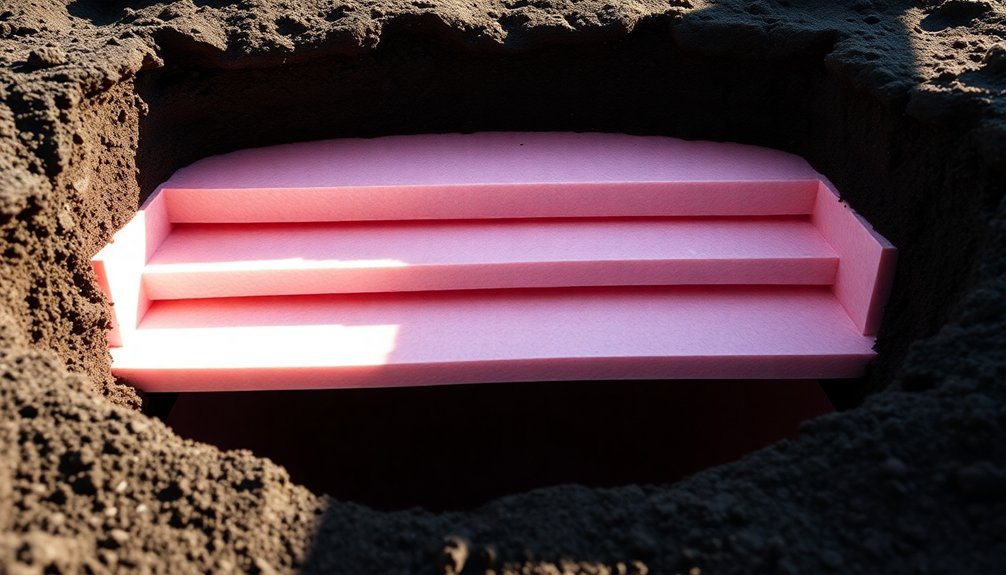
The inadequacy of polyisocyanurate (polyiso) for underground food storage becomes immediately clear when examining its core properties.
You'll find that polyiso isn't rated for ground contact or burial, making it unsuitable for food pit applications where ground moisture is a constant concern.
When you're storing food underground, you need materials that can withstand moisture and pressure, but polyiso falls short in both areas.
The material's tendency to absorb water will compromise its insulating properties, making your food storage less effective and potentially unsafe. Its relatively low compressive strength of around 15 psi won't hold up against the soil pressure in an underground pit. Watertight tie-ins would be impossible to maintain in an underground environment.
You'll want to avoid polyiso's moisture-related problems, as its tight pores and foil facing can trap water, leading to decreased R-value and increased weight.
While polyiso excels in above-ground applications, it's not your ally for underground food storage.
Instead, you should consider materials like EPS or XPS, which offer superior moisture resistance and higher compressive strengths.
These alternatives will provide better protection for your underground food storage needs while maintaining their insulating properties over time.
Ceramic Mat Thermal Systems
Ceramic mat thermal systems can protect your underground food pit with impressive temperature resistance up to 1250°C, though you'll typically operate well below this threshold for food storage.
You'll find these mats easy to work with since they're available in flexible forms that conform perfectly to your pit's walls and corners while providing superior insulation with thermal conductivity below 0.05 W/mK. These materials are vacuum-formed to ensure consistent quality and performance throughout the insulation layer.
The mat's moisture-resistant properties and chemical stability guarantee your stored food remains protected from ground moisture and environmental factors, making it an excellent choice for long-term underground storage solutions.
Temperature Resistance Properties
Remarkably resilient, modern ceramic mat thermal systems offer superior temperature resistance that makes them ideal for underground food storage. You'll find these materials can withstand temperatures up to 1,700°C, far exceeding what's needed for food preservation. When you're designing your underground food pit, ceramic thermal systems will protect your stores from both extreme heat and cold.
| Property | Performance |
|---|---|
| Max Temperature | Up to 1,700°C (3,092°F) |
| Chemical Stability | Resistant to aggressive media |
| Insulation Rating | High electrical resistance |
| Structural Integrity | Strong yet lightweight |
You won't need to worry about chemical reactions with the soil, as ceramic materials are chemically stable and non-corrosive. They'll maintain their protective properties even in harsh underground conditions where moisture and soil chemicals might damage other materials. The system's mechanical strength safeguards your pit's structure stays intact, while its non-conductive properties prevent any unwanted heat transfer from surrounding soil temperatures. The high purity alumina composition ensures precise dimensional stability for a properly sealed storage environment.
When you're selecting insulation for your food pit, you'll appreciate that ceramic fiber blankets can handle temperatures from 1,000°F to 2,696°F, though food storage typically requires much lower temperatures. This provides an ample safety margin for long-term storage stability.
Flexible Installation Options
When planning your underground food pit installation, you'll appreciate the exceptional flexibility of ceramic mat thermal systems. These lightweight mats are incredibly easy to handle and transport, making the installation process considerably more manageable.
You won't need specialized tools to cut or shape them, and they can be customized to fit your pit's specific dimensions without compromising their insulating properties.
The versatility of ceramic fiber mats allows you to adapt them to various underground configurations, including irregularly shaped pits. You can layer them to achieve your desired insulation performance and install them in tight spaces due to their flexibility.
They'll seamlessly integrate with other insulation materials and are compatible with metal, concrete, and wood substrates.
- You can quickly install these mats using standard fastening methods, reducing your overall project completion time.
- The mats' cross-locking orientation and needling process guarantee excellent handleability during installation.
- You'll find them particularly useful for both new installations and retrofitting existing pits, as they conform to any pit shape while maintaining their insulating effectiveness.
Moisture Protection Features
Beyond their installation advantages, you'll find that ceramic mat thermal systems offer superior moisture protection for your underground food storage.
These systems utilize high-purity ceramic materials that resist chemical exposure and effectively shield your food pit from moisture penetration. You'll benefit from their non-corrosive properties and exceptional dimensional tolerances that create reliable moisture barriers.
When you're dealing with underground storage, you'll appreciate that ceramic mats provide better protection than traditional fiber blankets.
The solid structure of ceramic materials makes them less susceptible to moisture ingress, while maintaining excellent thermal insulation properties. Their closed-end protection design acts as a protective sheath against external atmospheric conditions and ground moisture.
You won't need to worry about degradation over time, as these ceramic systems maintain their chemical stability even in aggressive environments.
With materials that can withstand temperatures up to 1,700°C while remaining moisture-resistant, your underground food pit stays dry and protected.
The high mechanical strength of materials like Rubalit® C799 guarantees your insulation remains intact, preventing moisture from compromising your food storage space through physical stress or environmental factors.
Foamglas Cellular Glass Barriers
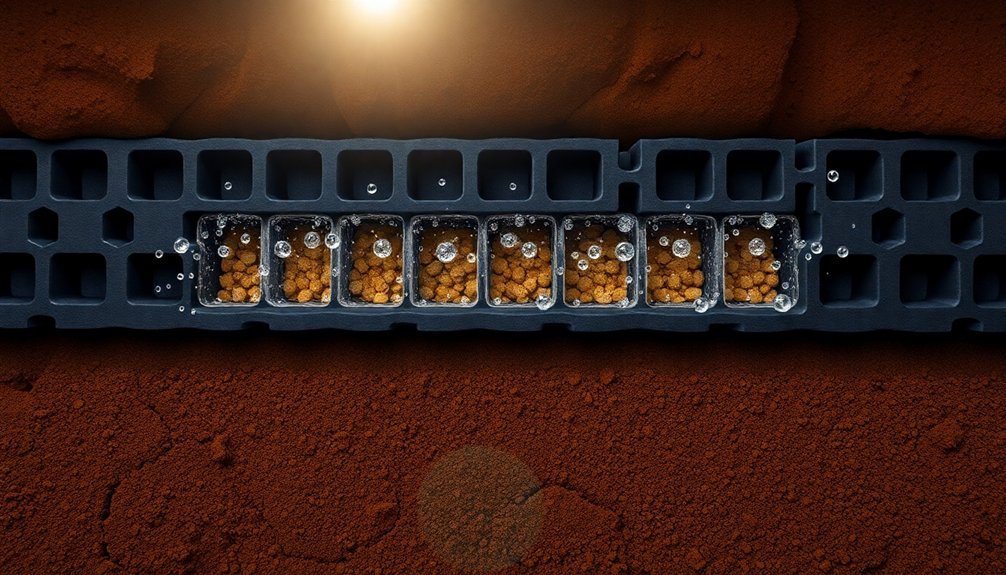
Foamglas Cellular Glass Barriers represent one of the most effective insulation materials for underground food storage pits, thanks to their unique composition of sealed glass cells.
You'll find that these barriers excel at protecting your stored food by maintaining consistent temperatures between -450°F and +900°F, while completely blocking moisture penetration.
Their dimensional stability means they won't shrink or swell over time, ensuring your storage pit remains properly sealed.
What makes Foamglas particularly suitable for food storage is its inert chemical nature and safety features. You won't need to worry about chemical reactions with your stored food, as it's resistant to acids and organic solvents.
The material's high compressive strength means it can handle the weight of soil above your storage pit without compromising its insulating properties.
- Won't deteriorate over time, maintaining long-term thermal efficiency without additional maintenance
- Can be directly buried without protective tunnels and doesn't require cathodic protection
- Protects against radon while preventing internal condensation, even in high humidity conditions
You can easily cut and install Foamglas to fit your specific pit dimensions, and when combined with PITTWRAP® jacketing, you'll get additional protection against challenging soil conditions.
Moisture-Resistant Kaiflex Applications
The protective layers of Kaiflex insulation offer exceptional moisture resistance for underground food storage through their advanced closed-cell structure. You'll find its high water vapor diffusion resistance (μ = 7,000 to ≥10,000) creates an impenetrable barrier that keeps your underground food pit dry and protected from moisture infiltration.
| Feature | Benefit |
|---|---|
| Temperature Range | Maintains integrity from -200°C to +150°C, ideal for varying ground temperatures |
| Antimicrobial Structure | Prevents food contamination and mold growth |
| Chemical Resistance | Protects against soil-based chemical degradation |
When you're installing Kaiflex in your underground food pit, you'll benefit from its flexible application options and self-adhesive products that create seamless barriers. The material's low thermal conductivity (λ ≤0.033 W/m·K) guarantees your stored food remains at consistent temperatures, while its closed-cell structure prevents vapor passage that could compromise food preservation.
You don't need to worry about safety concerns either – Kaiflex's fire-resistant properties (Euroclass B-s3, d0 for Kaiflex ST) provide additional protection. Its long-term performance characteristics guarantee reliable insulation throughout your food pit's service life, making it a practical choice for underground food storage systems.
Thick Styrofoam Wall Construction
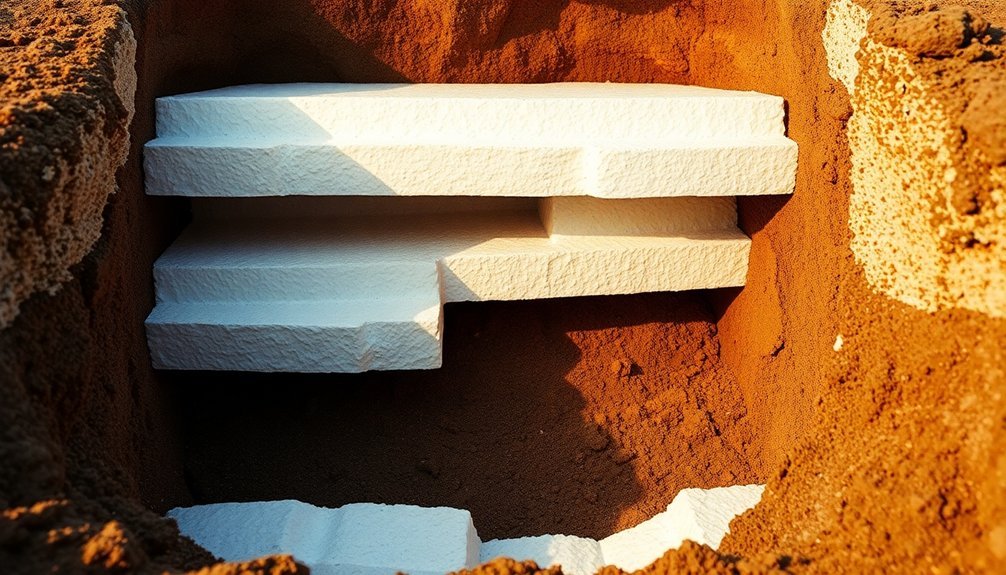
You'll want to start with a thick layer of styrofoam boards against your food pit's walls, building up multiple layers horizontally to create a robust insulation barrier.
To protect the styrofoam from moisture damage, you can wrap the exterior facing side with a weather-resistant membrane or heavy-duty plastic sheeting.
When backfilling around your insulated walls, you must carefully pack the soil to prevent gaps while ensuring you don't damage the weather seal or compromise the layered structure.
Layered Installation Techniques
During the construction of underground food pits, proper layered installation of thick Styrofoam walls requires careful attention to detail and precise measurements.
You'll need to start by verifying your pit depth accommodates all necessary layers while maintaining structural integrity. Cut your Styrofoam blocks to exact dimensions that fit your pit's specifications, considering both vertical and horizontal placement.
Begin the installation by laying your hot rocks or embers evenly across the bottom for ideal heat distribution. Next, install your thick Styrofoam insulation layer, making sure it's firmly secured against the pit walls. You'll want to create a solid barrier that prevents heat loss while resisting water penetration.
Add your middle layer of sand or additional Styrofoam blocks, followed by properly wrapped food items on a bed of banana leaves or similar insulation material.
- Place Styrofoam blocks edge-to-edge to eliminate any gaps that could compromise insulation
- Install blocks in a staggered pattern to prevent vertical seams from aligning
- Secure each layer firmly before adding the next to verify even weight distribution
Finally, seal your pit with a top layer of soil or sand to lock in heat and complete your insulation system. This layered approach maximizes energy efficiency and maintains consistent cooking temperatures throughout the process.
Weather Seal Protection Methods
Protecting your underground food pit's thick Styrofoam walls from weather damage requires proper sealing techniques to maintain insulation effectiveness. You'll want to focus on installing weather seals that prevent air infiltration and moisture while keeping pests out of your storage space.
Start by selecting teardrop weather seals with their foam inner core and 40 oz. vinyl fabric covering for your pit's primary protection. These seals work effectively for below-ground applications and provide excellent durability.
For areas where standard seals won't fit, use fabric weather seals with Hypalon covering, which offer flexibility and enhanced protection through their double-stitched fold design.
Don't forget to secure your seals properly using either galvanized channels or tek-screws for self-tapping installation. For gaps around the edges, install rear hinge foam seals made of fire-retardant polyurethane foam. You can opt for additional Hypalon wrapping on these seals for extra protection.
Complete your sealing system with lanyard cup seals made of durable polyurethane to prevent air infiltration from underneath. This thorough approach guarantees your food pit meets safety regulations while maintaining proper temperature control and moisture resistance.
Fiberglass Insulation With Protective Jacketing
Fiberglass insulation, when properly jacketed, offers a viable option for underground food pit insulation, though it requires careful moisture protection.
You'll need to combine factory-applied jackets like Foil-Skrim-Kraft (FSK) with field-applied protective materials such as PVC or metal jacketing to create an effective moisture barrier. Since fiberglass loses its thermal resistance when wet, it's essential to install proper drainage and maintain a waterproof seal.
For ideal protection, you'll want to apply the insulation and jacketing in 10-foot segments, ensuring each section is thoroughly sealed. The installation process requires a bed of compacted sand and must remain free of standing water.
You should consider using PITTWRAP® jacketing for additional waterproofing against soil conditions, particularly in areas with high moisture content.
- Combine factory-applied FSK jackets with metal or PVC field-applied jacketing for maximum protection
- Install drainage systems and maintain a dry environment during the entire installation process
- Apply protective coatings to the bore of the insulation if your food pit experiences frequent temperature changes
Remember that while fiberglass can attract rodents, proper metal or PVC jacketing will help deter pest intrusion while providing chemical resistance and easy cleaning capabilities.
Multi-Layer Ventilated Insulation Design
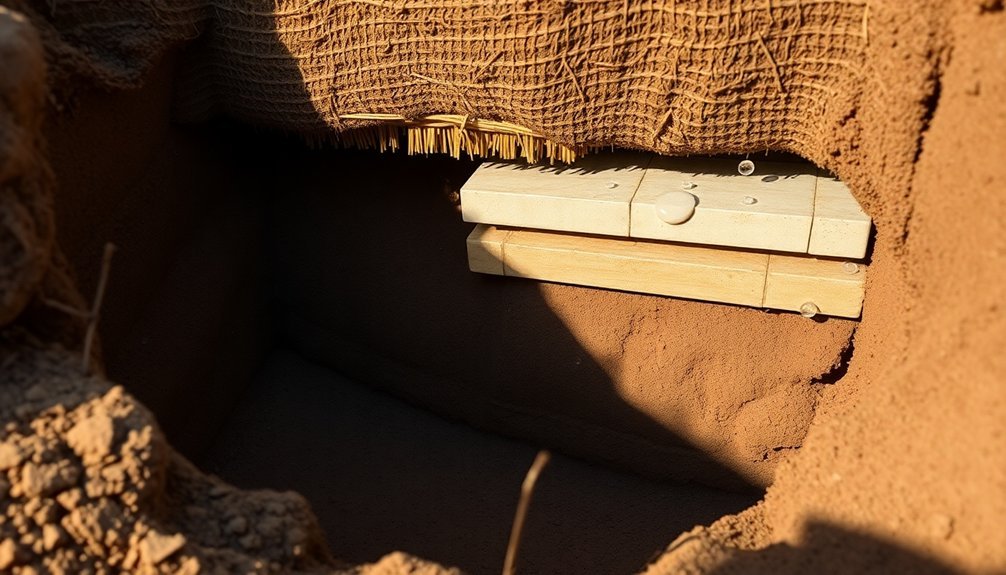
Multi-layer ventilated insulation's sophisticated design represents a major advancement for underground food storage. You'll need to work with multiple thin sheets of plastic, like Mylar or Kapton, each coated with metallic layers of silver or aluminum. The key to success lies in keeping these layers separated to prevent thermal conduction while maintaining proper ventilation.
For your underground food pit, you'll want to create a system of 40 or more layers, with stronger, fiberglass-reinforced materials on the outer sections. You can use embossed or crinkled layers that touch only at specific points, separated by thin cloth mesh.
Consider implementing NICS MLI with discrete spacers for enhanced performance, as this design considerably reduces heat transfer.
When installing the system, you'll need to prepare a proper foundation with compacted sand or gravel for drainage. Make sure you're maintaining consistent layer spacing throughout the installation.
Don't forget to inspect the layers regularly for damage or displacement. For specific soil conditions, you might need to add protective coatings to your outer layers to guarantee long-term durability and effectiveness of your underground storage system.
Frequently Asked Questions
How Long Can Different Types of Vegetables Be Stored in an Insulated Pit?
You'll find that root crops and most vegetables can be stored for several weeks under heavy mulch. After you open your storage pit, you'll need to use the produce within 1-2 weeks.
What Are the Estimated Costs per Square Foot for Different Insulation Materials?
You'll find fiberglass is cheapest at $0.30-$1.50/sq ft, cellulose costs $0.60-$2.30/sq ft, mineral wool ranges from $1.40-$4/sq ft, and closed cell spray foam is priciest at $2.25-$7.00/sq ft.
Can Multiple Food Storage Pits Be Connected Underground for Temperature Regulation?
Yes, you can connect multiple storage pits underground. You'll benefit from shared temperature regulation, improved stability, and efficient ventilation systems. Make sure you properly seal and insulate between chambers for ideal performance.
How Often Should Insulation Materials Be Replaced in Underground Food Storage?
You'll need to replace your underground storage insulation every 2-5 years for protective coatings, but materials like concrete and polystyrene foam can last 50+ years if they're properly maintained and show no degradation.
What Natural Insulation Alternatives Work Well for Underground Food Storage Pits?
You can effectively insulate your underground food storage using straw, hay, leaves, or moss as primary materials. They're natural, affordable, and work together to maintain ideal humidity and temperature while protecting your stored items.
In Summary
You'll find these seven insulation materials offer reliable temperature control and moisture resistance for your underground food storage pit. Whether you choose polyisocyanurate layers, ceramic mats, or multi-layer ventilated systems, proper installation is essential. Don't forget to monitor your pit's conditions regularly and maintain the insulation barriers. With the right material and maintenance, you're ensuring your stored food stays fresh and protected year-round.

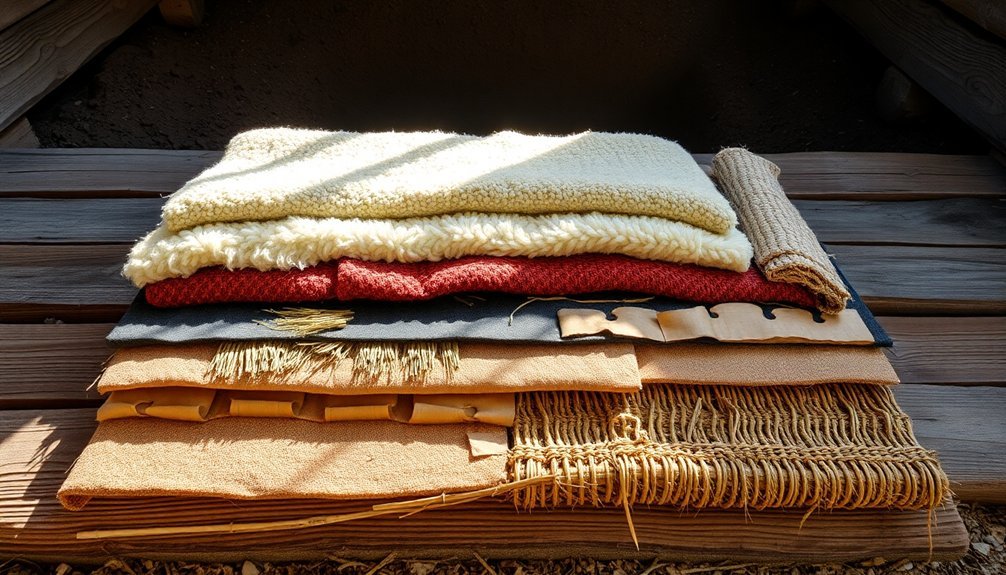



Leave a Reply